Top News

January 1, 2021 Ryukyu Shimpo
By Hiroe Nakagawa
Around 8:00 a.m. on January 1, a rainbow appeared arching over Mount Gusuku (also known as Tacchu), a symbol of Iejima, Okinawa.
Although there was thick cloud cover at the time of sunrise, approximately 7:15 a.m., the sun gradually began to appear from behind the clouds. After 7:40 a.m., rain fell in large drops even though the sun’s brightness spread across the sprawling blue sky. Thereafter, a double rainbow appeared arching over Mount Gusuku.
The risen sun shone on Mount Gusuku, resulting in beautiful scenery that seemed to signify a bright future.
(English translation by T&CT and Erin Jones)
Go to Japanese
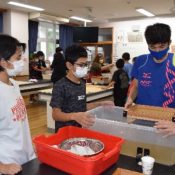
December 27, 2020 Ryukyu Shimpo
By Ikue Asato
Ogimi – In Ogimi, the home of basho-fu (traditional cloth made from banana fibers) and shikuwasa (Okinawa lime), 29 sixth graders at Ogimi Elementary School made diplomas from basho-shi (paper made from banana fibers) under the direction of the village board of education. This annual activity began four years ago, as part of the village board of education’s lifelong learning program. Starting on December 8, the children spent three days preparing the diplomas they will accept at graduation in March.
On the first day, pupils cut twigs and leaves of the shikuwasa with scissors and then boiled them to make a dye. On the second day, the children peeled basho (musa basjoo bananas) and thinly sliced the peels with a knife. They then boiled the peels, blended them in a blender, and passed the material through a laundry net.
During the kamisuki (paper-making) event, pupils received instruction from the coordinator of the Ogimi Village Board of Education Lifelong Learning Program and from local instructors in the art of making basho-shi. All of the pupils scooped the fibers using a suketa (bamboo frame) to complete the basho-shi. Some children had to try several times in order to get the basho fibers in an even layer on the frame.
Raimon Fukuchi, one of the pupils at Ogimi Elementary School, says, “Cutting the basho into one millimeter strips was hard. I think I got a feel for what I was doing during the kamisuki, and it came out well.”
(English translation by T&CT and Ellen Huntley)
Go to Japanese
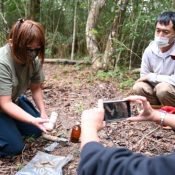
December 22, 2020 Ryukyu Shimpo
By Shohei Tsukazaki
“No Helipad” Takae Residents’ Association (“Helipaddo Iranai” Takae Jumin-no-kai) is a local group that protested the construction of helipads inside the U.S. Marine Corps Jungle Warfare Training Center, located in Higashi and Kunigami villages. The group now disseminates updates on military base issues through YouTube. December 22 marks four years since the helipads were completed and over half of the Jungle Warfare Training Center was reverted to Japan. Even after the reversion, residents of Takae are forced to deal with noise pollution. With trial and error, the “No Helipad” residents’ association is creating videos to convey the current situation in Takae.
The “No Helipad” Takae Residents’ Association created the YouTube channel “Arigato Yanbaru” in June. One member, Ikuko Isa, explained, “Many people were unable to travel to the site due to the pandemic, and we wanted to convey the situation on the ground to a diverse crowd.”
In its videos, the group explains the history of the helipad construction issue and shares the protestors’ voices. Some of the videos are subtitled in English so that people in Guam, where the U.S. Marines in Okinawa will relocate to, can also watch them.
In early December, the residents’ association made a video reporting on an area of the Jungle Warfare Training Center that was reverted to Japan in 1993, guided by a butterfly researcher, Akino Miyagi. In 2020 alone, waste materials believed to be left behind by the U.S. military, such as MREs and empty bottles, as well as hand grenades and bullets, have been found in the area. At another location in Ada, Kunigami Village, the group found electronic parts containing the radioactive substance cobalt-60. They collected the waste materials and asked the camera, “Shouldn’t the U.S. military clean up the site before returning it?”
Construction of the helicopter landing site began in 2007 and continued intermittently until its completion in July 2020, when the peripheral roads were finished. The residents’ association began protesting in 2007 through sit-ins and other means. To this day, they continue to monitor the helipad’s operation from a tent set up in front of the base’s N1 gate along Prefectural Highway 70.
Satoru Shimizu, a member of “No Helipad” Takae Residents’ Association, said, “The helipad is now completed, but we will demand its removal. We want to connect with the [other] islands through our videos.”
Visit the “No Helipad” Takae Residents’ Associateion Youtube channel at
https://www.youtube.com/channel/UCL-NmKPN-VqqLd3yLFV-oEw
or from the QR link below.
(English translation by T&CT and Monica Shingaki)
Go to Japanese
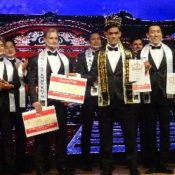
December 22, 2020 Ryukyu Shimpo
Onna – The “Mr. World Noble King 2020 Global Competition in Okinawa” (hosted by GLAWIS), which crowns one of the participants the “Best Man in the World,” was held December 20 at the Okinawa Kariyushi Beach Resort Ocean Spa in Onna. This is the first time the event was held in Japan.
Twenty men representing countries including Japan, the US, and India participated in the Grand Finale, and Ryunosuke Ahsan, 22, representing Bangladesh, was crowned the king of the pageant, taking home a prize of one million yen. Ahsan commented, “I had support from everyone. I want to thank everyone.”
Over the course of the competition, which took place from December 14 through 21, the representatives of each country engaged in community service such as cleaning the beaches. Based on a vote of the participants, the representative from Okinawa, Sei Kamida, 32, was voted “Mister Charity” for his enthusiasm for community service.
Mr. World Noble King choses the “Best Man in the World” based on a comprehensive view of beauty, including interior factors such as intelligence and personality, as well as physical beauty. The runner up in the contest was Xia Meng Nan, 30, and third place was given to Nihi, 29, from Germany.
(English translation by T&CT and Sam Grieb)
Go to Japanese
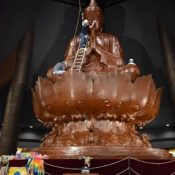
December 17, 2020 Ryukyu Shimpo
Itoman – On December 16, the Okinawa Peace Prayer Statue at the Okinawa Peace Hall in Mabuni, Itoman, was wiped clean of dust as part of a “cleansing” in preparation for the new year. In a normal year, around 20 people including bus tour guides would participate in removing dust from the statue. However, to prevent the spread of the novel coronavirus, only seven staff members from the Okinawa Foundation participated this year. The workers offered a moment of silence to pray for peace and wiped dust from every nook and cranny of the statue.
The Peace Prayer Statue is approximately 12 meters tall and 8 meters across. The late Shinzan Yamada made the prototype. The statue is “cleansed” twice each year, once before Okinawa Memorial Day on June 23, and once at the end of the year. Normally, the Mabuni Fire and Bell Festival would be held at the Peace Hall on the night of December 31. However, this year it has also been canceled due to the novel coronavirus.
Staff members clean dust from the Okinawa Peace Prayer Statue (December 16, the Okinawa Peace Hall in Mabuni, Itoman)
(English translation by T&CT and Ellen Huntley)
Go to Japanese

December 16, 2020 Ryukyu Shimpo
By Hirofumi Mazaki
Kitanakagusuku—On the evening of December 13, about 70 people gathered outside one of the gates to U.S. Marine Corps’ Camp Foster for the 33rd Christmas for Okinawans event, which was organized by various Christian denominations within Okinawa. Three years since a window fell from a U.S. military helicopter and landed on Futenma Daini Elementary School in Ginowan City and four years since the MV-22 Osprey (vertical takeoff and landing aircraft) crashed on a beach in Abe, Nago City, the carolers sang and prayed for peace.
While the Christmas event is usually held at a church, it was moved outdoors as a precaution against the novel coronavirus pandemic this year. According to the organizers, it is the first time they held an event at a military base gate. Eisho Uehara, the chair of the executive committee and bishop of the Diocese of Okinawa, Nippon Seikai, said, “There’s this division between ‘them’ and ‘us’ which is symbolized by the fence. I pray for a peaceful world in which this division no longer exists.”
Outside the gate, carollers sang Silent Night and Joy to the World, while children of military families waved at them from the other side of the fence. The organizers collected donations for Team Midorigaoka 1207 (a group working to prevent parts falling from aircrafts onto schools). Takako Nakamoto, 69, traveled from Naha City. She said, “Singing outside the gate made me realize that inside the base is Okinawa. I hope that the fence will be taken down one day, and we can sing carols together with the military personnel.”
(English translation by T&CT and Monica Shingaki)
Go to Japanese
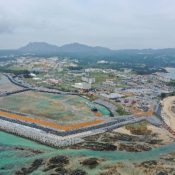
December 18, 2020 Ryukyu Shimpo
On November 11 the Association of War-Bereaved Families Opposed to War and Praying for Peace held a protest against the plan for collecting soil from the southern part of Okinawa Island and using the soil for land reclamation work in Henoko. The Association sent urgent notices to Prime Minister Yoshihide Suga, among others, requesting that this plan for soil collection be stopped. Takamatsu Gushiken, the president of the Gamafuya, a volunteer group dedicated to the recovery of remains of the Battle of Okinawa, has been asking the Okinawa Prefectural Government and the Okinawa Defense Bureau to put a stop to this soil collection plan, but this is the first time the Association of War-Bereaved Families has protested and asked for the soil collection to stop.
In the notice letter, the Association criticizes the plan for collecting large quantities of soil from the southern part of Okinawa Island and using the soil in the construction of the Futenma Replacement Facility in Henko, saying: “The prayers of bereaved families are being ignored, and we absolutely cannot permit soil [collection] as well as land reclamation”. The letter contains the request that soil collection, as part of the plan pertaining to FRF construction in Henoko, be stopped in all regions in which war-fallen soldiers are resting in peace. This notice was also sent to the Minister of Health, Labour and Welfare Norihisa Tamura; the Minister of Defense Nobuo Kishi; and the Minister of State for Okinawa Affairs Taro Kono.
(English translation by T&CT and Erin Jones)
Go to Japanese

December 17, 2020 Ryukyu Shimpo
The NPB Awards, which announces the season award winners in Nippon Professional Baseball (NPB), was held December 17, and the Rookie of the Year in the Pacific League was awarded to Seibu Lions’ right-handed relief pitcher Kaima Taira (21, Yaeyama Shoko High School). He is the first Okinawan native to win the rookie of the year award in professional baseball.
Taira was drafted by the Lions in the fourth round in 2017, entering the team in 2018.
This season, in his third year on the team, Taira was used as the set-up man, coming in just before the closer, appearing in a league high 54 games. In those games he recorded a record of one win, zero losses, a save, and a 1.87 ERA. He also recorded 33 holds, coming in second in the Pacific League to SoftBank’s Liván Moinelo’s 38. The outstanding achievement of making so many appearances without recording a single loss left a lasting impression across the league.
In July in a game against Rakuten, Taira recorded a fastball at a blistering 160 kph, the sixth fastest among Japanese players. He also showed an amazing presence as a relief pitcher, not allowing a single hit or earned run in his first 10 appearances of the season.
(English translation by T&CT and Sam Grieb)
Go to Japanese

November 29, 2020 Ryukyu Shimpo
On November 28, Takaaki Kajita, director of the Institute for Cosmic Ray Research at the University of Tokyo who was awarded the Nobel Prize in Physics in 2015, gave a speech at the Okinawa Institute of Science and Technology (OIST) Graduate University in Onna and explained the history and significance of neutrino research aimed at unraveling the mysteries of space. The speech was organized as part of the “Prefecture of Science: Spread Your Wings to the World! For the Scientists of the Future–a Nobel Prize-Winner from Okinawa” project by the Ryukyu Shimpo and OIST for educating the next generation. Around 170 high school students from Okinawa attended the speech.
Kajita was involved in the development of a device called the Kamiokande, aimed at observation of proton decay, under the guidance of Koshiba Masatoshi, who was awarded the Nobel Prize in Physics in 2002 and passed away on November 12, 2020. Although proton decay could not be observed, a program for observing and analyzing neutrinos flying from space was built. Kajita explained how this work led to the discovery of “oscillation” showing that neutrinos, which had been thought to lack mass, actually have mass.
Regarding his research, Kajita said, “It does not involve enriching people’s lifestyles, but understanding of the mechanisms of space serves as an asset shared by all of humanity.”
Kajita sent the message to the high schoolers who will lead the next generation that “I want you to cultivate the power to persevere and the power to see the importance of something when you come across something important” and “I want you to accumulate experience achieving things as part of a team.”
(English translation by T&CT and Sandi Aritza)
Go to Japanese
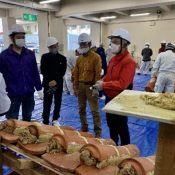
December 6, 2020 Ryukyu Shimpo
On December5, the Prefectural Ryukyu Aka-gawara Plastering Cooperative held a training course on plastering Ryukyu aka-gawara, or red earthen roof tiles, for plasterers from all over Okinawa, at the Prefectural Vocational Ability Development Association located in Nishi, Naha City. The course objective is to train new talent to preserve the traditional Okinawan scenery of earthen red roof tiles.
The participants worked in earnest to learn the traditional technique; Wearing serious expressions on their faces, they aligned the red earthen roof tiles and skillfully applied plaster to the gaps.
Tadashi Tabata, representative director of the cooperative, who served as the lecturer, explained that the Shuri Castle fire gave him more reasons to contemplate how to preserve the Ryukyuan plastering technique. Tabata explained the significance of the course and said, “Transfer of skills usually happens within an enclosed group. We need to open up and give various people the opportunity to come in contact with Ryukyu aka-gawara plastering.”
Tatsuya Nakazato, 57, traveled from Motobu for the course. He said, “It was a different experience from plastering a wall. I hope to make use of the skill I learned today.”
(English translation by T&CT and Monica Shingaki)
Go to Japanese
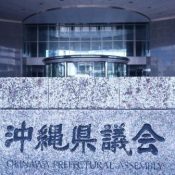
December 8, 2020 Ryukyu Shimpo
During the second day of general inquiries at the Okinawa Prefectural Assembly’s (OPA) regular November session December 7, eight members of the Okinawa-Liberal Democratic Party (LDP) faction took the podium. In response to a claim made by Chinese Foreign Minister Wang Yi stated regarding Japanese fishing boats operating in the ocean around the Senkaku Islands, “The fact is these were not mere fishing boats, and were entering the area as a provocation,” Okinawa Department of Agriculture, Forestry, and Fisheries chief commented, “The assertation that our prefecture’s fishing boats are ‘disguised fishing boats’ is absolutely impossible.” This was in response to a question by Ichiro Ohama, who represents the Ishigaki City district.
Hearing the remark about ‘disguised fishing boats,’ Ohama introduced harsh criticism given by Japanese Communist Party (JCP) chairman Kazuo Shii, who called China “arrogant.” Ohama agreed, saying, “I think it is a fair criticism. This can only be seen as reckless words.” The OPA adopted the statement of the usually antagonistic party leader in a rare moment of praise.
Okinawa vice-governor Kiichiro Jahana touched on China’s announcement of a new law that would allow its coast guard the use of weapons to defend Chinese-claimed waters, stressing, “He had a strong sense of wariness.” Additionally, Jahana noted the maritime crisis management framework agreed to by both former prime minister Shinzo Abe and Chairman Xi Jinping in order to avoid a clash between Japan’s Self-Defense Forces and China’s People’s Liberation Army, commenting “I think it is extremely important for us to avoid an unexpected incident.”
In addition, assembly members Ryotaro Odo, Tomoko Ishihara, Hiroshi Goya, Tadaaki Shimajiri, Ieharu Nakamura, Yohsitoyo Arakaki, and Moriyuki Teruya all spoke.
(English Translation by T&CT and Sam Grieb)
Go to Japanese











 Webcam(Kokusai Street)
Webcam(Kokusai Street)


